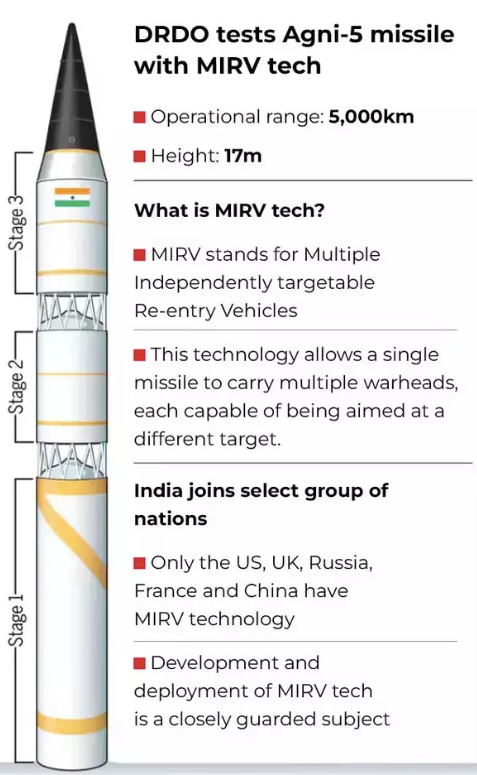
Mission Divyastra Agni – 5 Missile with MIRV Technology. ( Source – Civilsdaily Wikipedia Page )
You know India recently conducted a successful test of a new version of its Agni missile called Agni-5, as part of Mission Divyastra.
This Agni-5 missile is special because it has MIRV technology, which stands for Multiple Independently Targetable Re-entry Vehicle. Do you know what is Independently Targetable Re-entry Vehicle let me explain it in simple language.
Multiple Independently Targetable Re-entry Vehicle (MIRV) is a term for a technology that is used in missiles that lets one missile carry lots of smaller missiles. These smaller missiles, called warheads, can each go after different targets all at once. For example, one big missile splits into many smaller ones, each going to a different place to cause damage. This makes the missile super powerful because it can attack lots of places all at the same time. MIRV missiles are like a multitasking weapon – they can hit multiple targets with precision, making them very effective in military operations. They’re also hard for enemy defenses to stop because there are so many incoming threats at once. Therefore, MIRV technology makes missiles a lot scarier and more powerful in battle.
 India tests Agni -5 missile with MIRV technology and sends a message to Pakistan and China.( Source – Times of India)
India tests Agni -5 missile with MIRV technology and sends a message to Pakistan and China.( Source – Times of India)This is a big step forward in India’s missile capabilities and shows that India is making significant progress in its defense technology
Do you know the historical background of the Agni missile, let me explain to you, Agni missiles have been a part of India’s defense arsenal since the early 1990s. Agni-5, however, stands out due to its MIRV technology. MIRV allows a single missile to carry multiple warheads, each capable of targeting different locations independently. This capability enhances the effectiveness of the missile, particularly in scenarios where multiple targets need to be neutralized simultaneously.
MIRV technology, which stands for Multiple Independently Targetable Re-entry Vehicles, is a game-changer in military operations because it gives a country more power to defend itself and attack its enemies. With MIRV, a single missile can carry many smaller warheads, each capable of hitting different targets. This means that instead of launching several missiles to attack different places, one missile can do the job. This makes it easier to hit important enemy targets like military bases or command centers. Also, MIRV missiles make it harder for the enemy to stop the attack because they have to deal with multiple warheads coming at them all at once. So, MIRV technology gives a country more strength and makes it harder for its enemies to defend themselves.
You should know how it impacts India’s International relations:
You know the development and deployment of MIRV technology in missiles like Agni-5 can have significant implications for international relations. First of all, India’s possession of MIRV-equipped missiles may change how other countries perceive its military strength. For example, neighboring countries or global powers might view India as a more formidable military force, potentially leading to shifts in alliances or strategic partnerships in the region. Secondly, the deployment of MIRV missiles by India could increase tensions with neighboring countries, particularly those with whom India has historical rivalries or territorial disputes. This could lead to concerns about escalation and destabilization in the region, prompting other countries to reassess their defense strategies. Additionally, the development of MIRV technology by India might prompt other countries in the region, such as Pakistan or China, to enhance their missile capabilities in response, potentially sparking an arms race and heightening security concerns for all parties involved. Overall, the adoption of MIRV technology by India can significantly influence diplomatic relations, security policies, and regional dynamics, emphasizing the importance of dialogue and cooperation to maintain stability and peace in South Asia.
When was the Agni-5 last tested?
The Agni-5 missile, a part of India’s missile arsenal, was last tested successfully in December 2022, off the coast of Odisha. This missile, along with other variants like Agni-1 to Agni-4, has different ranges, with Agni-5 capable of reaching distances of 5,000 kilometers or more.
In addition, India tested Agni P in June 2021, a missile that can be launched from road and rail platforms, allowing for quicker deployment. The development of Agni-5 was announced in 2007, with plans for it to carry multiple warheads, a feature aimed at enhancing its destructive capabilities.
The pursuit of MIRV technology, as mentioned by former DRDO director general V K Saraswat, is part of India’s efforts to multiply the destructive potential of its missiles. This pursuit is seen in the context of regional rivalry with China, with perceived advantages including balancing the land-based ballistic missile forces, establishing a credible sea-based nuclear deterrent, and providing a hedge against the potential deployment of ballistic missile defense systems by China.
therefore, India’s development and testing of Agni missiles, coupled with advancements in MIRV technology, underscore its strategic goals in maintaining deterrence and security in the region.
What makes MIRV technology especially lethal?
MIRV technology, or Multiple Independently Targetable Re-entry Vehicle technology, is exceptionally lethal because it allows a single missile to carry multiple warheads, unlike traditional missiles that carry only one warhead. These warheads can be released from the missile at different speeds and directed toward multiple targets, increasing the devastation potential of each missile. Developing MIRV technology is challenging due to the need for large missiles, small warheads, precise guidance systems, and complex mechanisms for releasing warheads during flight. As a result, only a few countries, including the USA and the Soviet Union, have successfully developed MIRV capabilities. India has recently joined this exclusive club, highlighting its advanced missile technology capabilities and its potential impact on global security dynamics.